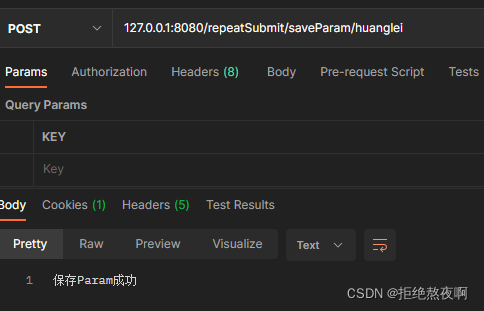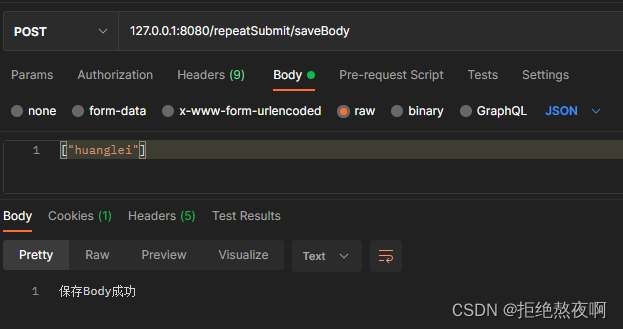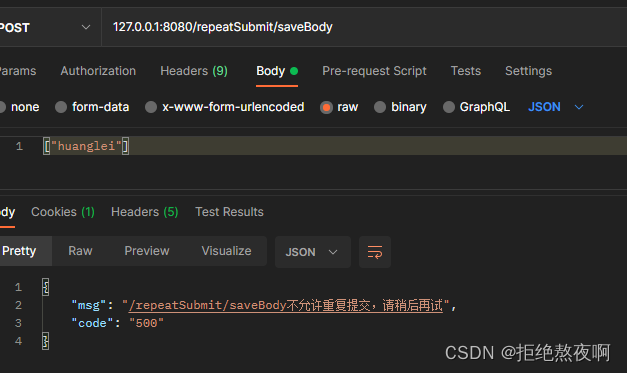SpringBoot基于redis自定义注解实现后端接口防重复提交校验
目录
- 一、添加依赖
- 二、代码实现
- 三、测试
一、添加依赖
<dependency>
<groupId>org.springframework.boot</groupId>
<artifactId>spring-boot-starter-redis</artifactId>
<version>1.4.4.RELEASE</version>
</dependency>
<dependency>
<groupId>redis.clients</groupId>
<artifactId>jedis</artifactId>
<version>3.6.3</version>
</dependency>
<dependency>
<groupId>com.alibaba</groupId>
<artifactId>fastjson</artifactId>
<version>1.2.75</version>
</dependency>
二、代码实现
1.构建可重复读取inputStream的request
package com.hl.springbootrepetitionsubmit.servlet;
import javax.servlet.*;
import javax.servlet.http.*;
import java.io.*;
import java.nio.charset.StandardCharsets;
/**
* 构建可重复读取inputStream的request
*/
public class RepeatedlyRequestWrapper extends HttpServletRequestWrapper {
private final String body;
public RepeatedlyRequestWrapper(HttpServletRequest request, ServletResponse response) throws IOException {
super(request);
request.setCharacterEncoding("UTF-8");
response.setCharacterEncoding("UTF-8");
body = getBodyString(request);
}
@Override
public BufferedReader getReader() throws IOException {
return new BufferedReader(new InputStreamReader(getInputStream()));
}
public String getBody() {
return body;
}
@Override
public ServletInputStream getInputStream() throws IOException {
final ByteArrayInputStream bais = new ByteArrayInputStream(body.getBytes(StandardCharsets.UTF_8));
return new ServletInputStream() {
@Override
public int read() throws IOException {
return bais.read();
}
@Override
public int available() throws IOException {
return body.length();
}
@Override
public boolean isFinished() {
return false;
}
@Override
public boolean isReady() {
return false;
}
@Override
public void setReadListener(ReadListener readListener) {
}
};
}
/**
* 获取Request请求body内容
*
* @param request
* @return
*/
private String getBodyString(ServletRequest request) {
StringBuilder sb = new StringBuilder();
BufferedReader reader = null;
try (InputStream inputStream = request.getInputStream()) {
reader = new BufferedReader(new InputStreamReader(inputStream, StandardCharsets.UTF_8));
String line = "";
while ((line = reader.readLine()) != null) {
sb.append(line);
}
} catch (IOException e) {
e.printStackTrace();
} finally {
if (reader != null) {
try {
reader.close();
} catch (IOException e) {
e.printStackTrace();
}
}
}
return sb.toString();
}
}
2.重写request
package com.hl.springbootrepetitionsubmit.filter;
import com.hl.springbootrepetitionsubmit.servlet.RepeatedlyRequestWrapper;
import org.springframework.http.MediaType;
import org.springframework.util.StringUtils;
import javax.servlet.*;
import javax.servlet.http.HttpServletRequest;
import java.io.IOException;
/**
* 过滤器(重写request)
*/
public class RepeatableFilter implements Filter {
@Override
public void doFilter(ServletRequest request, ServletResponse response, FilterChain chain) throws IOException, ServletException {
ServletRequest requestWrapper = null;
//将原生的request变为可重复读取inputStream的request
if (request instanceof HttpServletRequest
&& StringUtils.startsWithIgnoreCase(request.getContentType(), MediaType.APPLICATION_JSON_VALUE)) {
requestWrapper = new RepeatedlyRequestWrapper((HttpServletRequest) request, response);
}
if (null == requestWrapper) {
chain.doFilter(request, response);
} else {
chain.doFilter(requestWrapper, response);
}
}
}
3.自定义注解
/**
* 自定义注解防止表单重复提交
*/
@Inherited
@Target(ElementType.METHOD)
@Retention(RetentionPolicy.RUNTIME)
@Documented
public @interface RepeatSubmit {
}
4.创建防止重复提交拦截器
package com.hl.springbootrepetitionsubmit.interceptor;
import cn.hutool.core.util.StrUtil;
import com.alibaba.fastjson.JSONObject;
import com.hl.springbootrepetitionsubmit.annotation.RepeatSubmit;
import com.hl.springbootrepetitionsubmit.config.RedisUtil;
import com.hl.springbootrepetitionsubmit.servlet.RepeatedlyRequestWrapper;
import org.springframework.beans.factory.annotation.*;
import org.springframework.stereotype.Component;
import org.springframework.web.method.HandlerMethod;
import org.springframework.web.servlet.HandlerInterceptor;
import javax.servlet.http.*;
import java.io.IOException;
import java.lang.reflect.Method;
import java.util.*;
import java.util.concurrent.TimeUnit;
/**
* 防止重复提交拦截器
*/
@Component
public class RepeatSubmitInterceptor implements HandlerInterceptor {
public final String REPEAT_PARAMS = "repeatParams";
public final String REPEAT_TIME = "repeatTime";
/**
* 防重提交 redis key
*/
public final String REPEAT_SUBMIT_KEY = "repeat_submit:";
// 令牌自定义标识
@Value("${token.header}")
private String header;
@Autowired
private RedisUtil redisUtil;
/**
* 间隔时间,单位:秒
* <p>
* 两次相同参数的请求,如果间隔时间大于该参数,系统不会认定为重复提交的数据
*/
@Value("${repeatSubmit.intervalTime}")
private int intervalTime;
@Override
public boolean preHandle(HttpServletRequest request, HttpServletResponse response, Object handler) throws Exception {
if (handler instanceof HandlerMethod) {
HandlerMethod handlerMethod = (HandlerMethod) handler;
Method method = handlerMethod.getMethod();
RepeatSubmit annotation = method.getAnnotation(RepeatSubmit.class);
if (annotation != null) {
if (this.isRepeatSubmit(request)) {
//返回重复提交提示
Map<String, Object> resultMap = new HashMap<>();
resultMap.put("code", "500");
resultMap.put("msg", request.getRequestURI() + "不允许重复提交,请稍后再试");
try {
response.setStatus(200);
response.setContentType("application/json");
response.setCharacterEncoding("utf-8");
response.getWriter().print(JSONObject.toJSONString(resultMap));
} catch (IOException e) {
e.printStackTrace();
}
return false;
}
}
return true;
} else {
return preHandle(request, response, handler);
}
}
/**
* 验证是否重复提交由子类实现具体的防重复提交的规则
*/
public boolean isRepeatSubmit(HttpServletRequest request) {
String nowParams = "";
if (request instanceof RepeatedlyRequestWrapper) {
RepeatedlyRequestWrapper repeatedlyRequest = (RepeatedlyRequestWrapper) request;
nowParams = repeatedlyRequest.getBody();
}
// body参数为空,获取Parameter的数据
if (StrUtil.isBlank(nowParams)) {
nowParams = JSONObject.toJSONString(request.getParameterMap());
}
Map<String, Object> nowDataMap = new HashMap<String, Object>();
nowDataMap.put(REPEAT_PARAMS, nowParams);
nowDataMap.put(REPEAT_TIME, System.currentTimeMillis());
// 请求地址(作为存放cache的key值)
String url = request.getRequestURI();
// 唯一值(没有消息头则使用请求地址)
String submitKey = request.getHeader(header);
if (StrUtil.isBlank(submitKey)) {
submitKey = url;
}
// 唯一标识(指定key + 消息头)
String cacheRepeatKey = REPEAT_SUBMIT_KEY + submitKey;
Object sessionObj = redisUtil.getCacheObject(cacheRepeatKey);
if (sessionObj != null) {
Map<String, Object> sessionMap = (Map<String, Object>) sessionObj;
if (sessionMap.containsKey(url)) {
Map<String, Object> preDataMap = (Map<String, Object>) sessionMap.get(url);
if (compareParams(nowDataMap, preDataMap) && compareTime(nowDataMap, preDataMap)) {
return true;
}
}
}
Map<String, Object> cacheMap = new HashMap<String, Object>();
cacheMap.put(url, nowDataMap);
redisUtil.setCacheObject(cacheRepeatKey, cacheMap, intervalTime, TimeUnit.SECONDS);
return false;
}
/**
* 判断参数是否相同
*/
private boolean compareParams(Map<String, Object> nowMap, Map<String, Object> preMap) {
String nowParams = (String) nowMap.get(REPEAT_PARAMS);
String preParams = (String) preMap.get(REPEAT_PARAMS);
return nowParams.equals(preParams);
}
/**
* 判断两次间隔时间
*/
private boolean compareTime(Map<String, Object> nowMap, Map<String, Object> preMap) {
long time1 = (Long) nowMap.get(REPEAT_TIME);
long time2 = (Long) preMap.get(REPEAT_TIME);
if ((time1 - time2) < (this.intervalTime * 1000L)) {
return true;
}
return false;
}
}
5.redis配置
package com.hl.springbootrepetitionsubmit.config;
import org.springframework.cache.CacheManager;
import org.springframework.cache.annotation.CachingConfigurerSupport;
import org.springframework.cache.interceptor.KeyGenerator;
import org.springframework.context.annotation.Bean;
import org.springframework.context.annotation.Configuration;
import org.springframework.data.redis.cache.RedisCacheConfiguration;
import org.springframework.data.redis.cache.RedisCacheManager;
import org.springframework.data.redis.connection.RedisStandaloneConfiguration;
import org.springframework.data.redis.connection.jedis.JedisClientConfiguration;
import org.springframework.data.redis.connection.jedis.JedisConnectionFactory;
import org.springframework.data.redis.core.RedisTemplate;
import org.springframework.data.redis.serializer.GenericJackson2JsonRedisSerializer;
import org.springframework.data.redis.serializer.RedisSerializationContext;
import org.springframework.data.redis.serializer.StringRedisSerializer;
import redis.clients.jedis.JedisPool;
import redis.clients.jedis.JedisPoolConfig;
import java.time.Duration;
@Configuration
public class RedisConfig extends CachingConfigurerSupport {
//配置redis的过期时间
private static final Duration TIME_TO_LIVE = Duration.ZERO;
@Bean(name = "jedisPoolConfig")
public JedisPoolConfig jedisPoolConfig() {
JedisPoolConfig jedisPoolConfig = new JedisPoolConfig();
//控制一个pool可分配多少个jedis实例
jedisPoolConfig.setMaxTotal(500);
//最大空闲数
jedisPoolConfig.setMaxIdle(200);
//每次释放连接的最大数目,默认是3
jedisPoolConfig.setNumTestsPerEvictionRun(1024);
//逐出扫描的时间间隔(毫秒) 如果为负数,则不运行逐出线程, 默认-1
jedisPoolConfig.setTimeBetweenEvictionRunsMillis(30000);
//连接的最小空闲时间 默认1800000毫秒(30分钟)
jedisPoolConfig.setMinEvictableIdleTimeMillis(-1);
jedisPoolConfig.setSoftMinEvictableIdleTimeMillis(10000);
//最大建立连接等待时间。如果超过此时间将接到异常。设为-1表示无限制。
jedisPoolConfig.setMaxWaitMillis(1500);
jedisPoolConfig.setTestOnBorrow(true);
jedisPoolConfig.setTestWhileIdle(true);
jedisPoolConfig.setTestOnReturn(false);
jedisPoolConfig.setJmxEnabled(true);
jedisPoolConfig.setBlockWhenExhausted(false);
return jedisPoolConfig;
}
@Bean("connectionFactory")
public JedisConnectionFactory connectionFactory() {
RedisStandaloneConfiguration redisStandaloneConfiguration = new RedisStandaloneConfiguration();
redisStandaloneConfiguration.setHostName("127.0.0.1");
redisStandaloneConfiguration.setDatabase(0);
// redisStandaloneConfiguration.setPassword(RedisPassword.of("123456"));
redisStandaloneConfiguration.setPort(6379);
//获得默认的连接池构造器
JedisClientConfiguration.JedisPoolingClientConfigurationBuilder jpcb =
(JedisClientConfiguration.JedisPoolingClientConfigurationBuilder) JedisClientConfiguration.builder();
//指定jedisPoolConifig来修改默认的连接池构造器(真麻烦,滥用设计模式!)
jpcb.poolConfig(jedisPoolConfig());
//通过构造器来构造jedis客户端配置
JedisClientConfiguration jedisClientConfiguration = jpcb.build();
//单机配置 + 客户端配置 = jedis连接工厂
return new JedisConnectionFactory(redisStandaloneConfiguration, jedisClientConfiguration);
}
@Bean("jedisPool")
public JedisPool jedisPool(){
return new JedisPool(jedisPoolConfig(),"127.0.0.1",6379);
}
@Bean
public RedisTemplate<Object, Object> redisTemplate(JedisConnectionFactory connectionFactory) {
RedisTemplate<Object, Object> redisTemplate = new RedisTemplate<>();
redisTemplate.setConnectionFactory(connectionFactory);
GenericJackson2JsonRedisSerializer jackson2JsonRedisSerializer = new GenericJackson2JsonRedisSerializer();
redisTemplate.setKeySerializer(new StringRedisSerializer());
redisTemplate.setHashKeySerializer(new StringRedisSerializer());
redisTemplate.setValueSerializer(jackson2JsonRedisSerializer);
redisTemplate.setHashValueSerializer(jackson2JsonRedisSerializer);
//初始化参数和初始化工作
redisTemplate.afterPropertiesSet();
return redisTemplate;
}
/**
* 缓存对象集合中,缓存是以key-value形式保存的,
* 当不指定缓存的key时,SpringBoot会使用keyGenerator生成Key。
*/
@Override
@Bean
public KeyGenerator keyGenerator() {
return (target, method, params) -> {
StringBuilder sb = new StringBuilder();
//类名+方法名
sb.append(target.getClass().getName());
sb.append(method.getName());
for (Object obj : params) {
sb.append(obj.toString());
}
return sb.toString();
};
}
/**
* 缓存管理器
* @param connectionFactory 连接工厂
* @return cacheManager
*/
@Bean
public CacheManager cacheManager(JedisConnectionFactory connectionFactory) {
//新建一个Jackson2JsonRedis的redis存储的序列化方式
GenericJackson2JsonRedisSerializer genericJackson2JsonRedisSerializer = new GenericJackson2JsonRedisSerializer();
//解决查询缓存转换异常的问题
// 配置序列化(解决乱码的问题)
//entryTtl设置过期时间
//serializeValuesWith设置redis存储的序列化方式
RedisCacheConfiguration config = RedisCacheConfiguration.defaultCacheConfig()
.entryTtl(TIME_TO_LIVE)
.serializeValuesWith(RedisSerializationContext.SerializationPair.fromSerializer(genericJackson2JsonRedisSerializer))
.disableCachingNullValues();
//定义要返回的redis缓存管理对象
return RedisCacheManager.builder(connectionFactory).cacheDefaults(config).build();
}
}
6.redis工具类
package com.hl.springbootrepetitionsubmit.config;
import org.springframework.beans.factory.annotation.Autowired;
import org.springframework.data.redis.core.BoundSetOperations;
import org.springframework.data.redis.core.HashOperations;
import org.springframework.data.redis.core.RedisTemplate;
import org.springframework.data.redis.core.ValueOperations;
import org.springframework.stereotype.Component;
import java.util.*;
import java.util.concurrent.TimeUnit;
@Component
public class RedisUtil {
@Autowired
private RedisTemplate redisTemplate;
/**
* 缓存基本的对象,Integer、String、实体类等
*
* @param key 缓存的键值
* @param value 缓存的值
*/
public <T> void setCacheObject(final String key, final T value) {
redisTemplate.opsForValue().set(key, value);
}
/**
* 缓存基本的对象,Integer、String、实体类等
*
* @param key 缓存的键值
* @param value 缓存的值
* @param timeout 时间
* @param timeUnit 时间颗粒度
*/
public <T> void setCacheObject(final String key, final T value, final Integer timeout, final TimeUnit timeUnit) {
redisTemplate.opsForValue().set(key, value, timeout, timeUnit);
}
/**
* 设置有效时间
*
* @param key Redis键
* @param timeout 超时时间
* @return true=设置成功;false=设置失败
*/
public boolean expire(final String key, final long timeout) {
return expire(key, timeout, TimeUnit.SECONDS);
}
/**
* 设置有效时间
*
* @param key Redis键
* @param timeout 超时时间
* @param unit 时间单位
* @return true=设置成功;false=设置失败
*/
public boolean expire(final String key, final long timeout, final TimeUnit unit) {
return redisTemplate.expire(key, timeout, unit);
}
/**
* 获得缓存的基本对象。
*
* @param key 缓存键值
* @return 缓存键值对应的数据
*/
public <T> T getCacheObject(final String key) {
ValueOperations<String, T> operation = redisTemplate.opsForValue();
return operation.get(key);
}
/**
* 删除单个对象
*
* @param key
*/
public boolean deleteObject(final String key) {
return redisTemplate.delete(key);
}
/**
* 删除集合对象
*
* @param collection 多个对象
* @return
*/
public long deleteObject(final Collection collection) {
return redisTemplate.delete(collection);
}
/**
* 缓存List数据
*
* @param key 缓存的键值
* @param dataList 待缓存的List数据
* @return 缓存的对象
*/
public <T> long setCacheList(final String key, final List<T> dataList) {
Long count = redisTemplate.opsForList().rightPushAll(key, dataList);
return count == null ? 0 : count;
}
/**
* 获得缓存的list对象
*
* @param key 缓存的键值
* @return 缓存键值对应的数据
*/
public <T> List<T> getCacheList(final String key) {
return redisTemplate.opsForList().range(key, 0, -1);
}
/**
* 缓存Set
*
* @param key 缓存键值
* @param dataSet 缓存的数据
* @return 缓存数据的对象
*/
public <T> BoundSetOperations<String, T> setCacheSet(final String key, final Set<T> dataSet) {
BoundSetOperations<String, T> setOperation = redisTemplate.boundSetOps(key);
Iterator<T> it = dataSet.iterator();
while (it.hasNext()) {
setOperation.add(it.next());
}
return setOperation;
}
/**
* 获得缓存的set
*
* @param key
* @return
*/
public <T> Set<T> getCacheSet(final String key) {
return redisTemplate.opsForSet().members(key);
}
/**
* 缓存Map
*
* @param key
* @param dataMap
*/
public <T> void setCacheMap(final String key, final Map<String, T> dataMap) {
if (dataMap != null) {
redisTemplate.opsForHash().putAll(key, dataMap);
}
}
/**
* 获得缓存的Map
*
* @param key
* @return
*/
public <T> Map<String, T> getCacheMap(final String key) {
return redisTemplate.opsForHash().entries(key);
}
/**
* 往Hash中存入数据
*
* @param key Redis键
* @param hKey Hash键
* @param value 值
*/
public <T> void setCacheMapValue(final String key, final String hKey, final T value) {
redisTemplate.opsForHash().put(key, hKey, value);
}
/**
* 获取Hash中的数据
*
* @param key Redis键
* @param hKey Hash键
* @return Hash中的对象
*/
public <T> T getCacheMapValue(final String key, final String hKey) {
HashOperations<String, String, T> opsForHash = redisTemplate.opsForHash();
return opsForHash.get(key, hKey);
}
/**
* 获取多个Hash中的数据
*
* @param key Redis键
* @param hKeys Hash键集合
* @return Hash对象集合
*/
public <T> List<T> getMultiCacheMapValue(final String key, final Collection<Object> hKeys) {
return redisTemplate.opsForHash().multiGet(key, hKeys);
}
/**
* 获得缓存的基本对象列表
*
* @param pattern 字符串前缀
* @return 对象列表
*/
public Collection<String> keys(final String pattern) {
return redisTemplate.keys(pattern);
}
}
7.配置拦截器
/**
* 防重复提交配置
*/
@Configuration
public class RepeatSubmitConfig implements WebMvcConfigurer {
@Autowired
private RepeatSubmitInterceptor repeatSubmitInterceptor;
/**
* 添加防重复提交拦截
*/
@Override
public void addInterceptors(InterceptorRegistry registry) {
registry.addInterceptor(repeatSubmitInterceptor).addPathPatterns("/**");
}
/**
* 生成防重复提交过滤器(重写request)
* @return FilterRegistrationBean
*/
@SuppressWarnings({ "rawtypes", "unchecked" })
@Bean
public FilterRegistrationBean<?> createRepeatableFilter() {
FilterRegistrationBean registration = new FilterRegistrationBean();
registration.setFilter(new RepeatableFilter());
registration.addUrlPatterns("/*");
registration.setName("repeatableFilter");
registration.setOrder(FilterRegistrationBean.LOWEST_PRECEDENCE);
return registration;
}
}
8.controller
@RestController
@RequestMapping("/repeatSubmit")
public class RepeatSubmitController {
/**
* 保存Param
* @param name
* @return
*/
@RepeatSubmit
@PostMapping("/saveParam/{name}")
public String saveParam(@PathVariable("name")String name){
return "保存Param成功";
}
/**
* 保存Param
* @param name
* @return
*/
@RepeatSubmit
@PostMapping("/saveBody")
public String saveBody(@RequestBody List<String> name){
return "保存Body成功";
}
}
三、测试
param传参:


body传参:


到此这篇关于SpringBoot基于redis自定义注解实现后端接口防重复提交校验的文章就介绍到这了,更多相关SpringBoot 接口防重复提交校验内容请搜索我们以前的文章或继续浏览下面的相关文章希望大家以后多多支持我们!
赞 (0)

